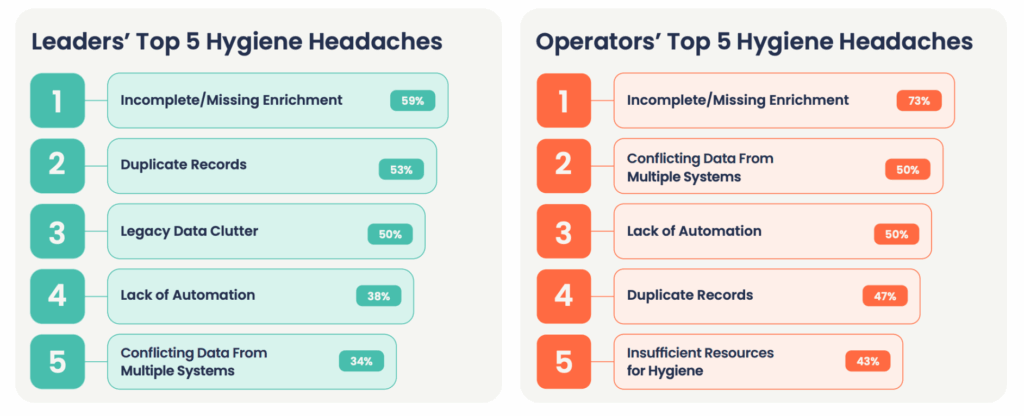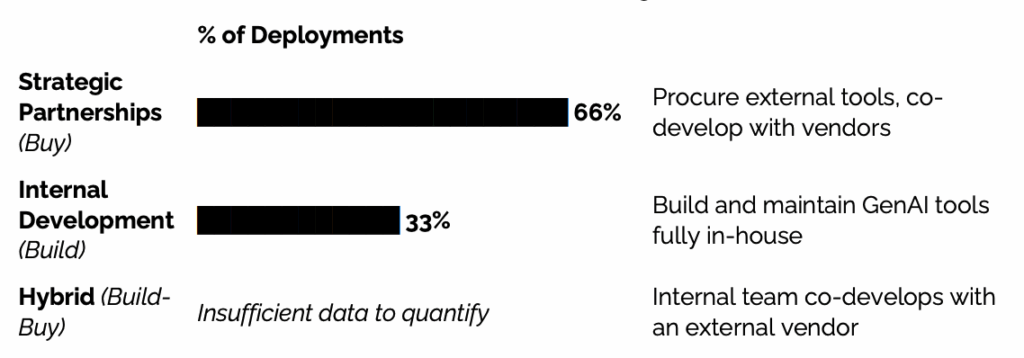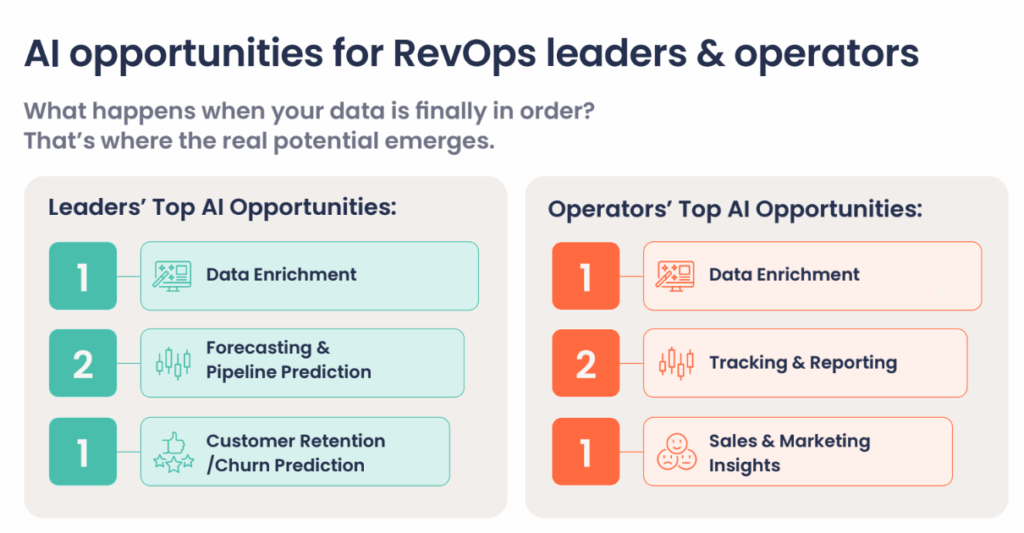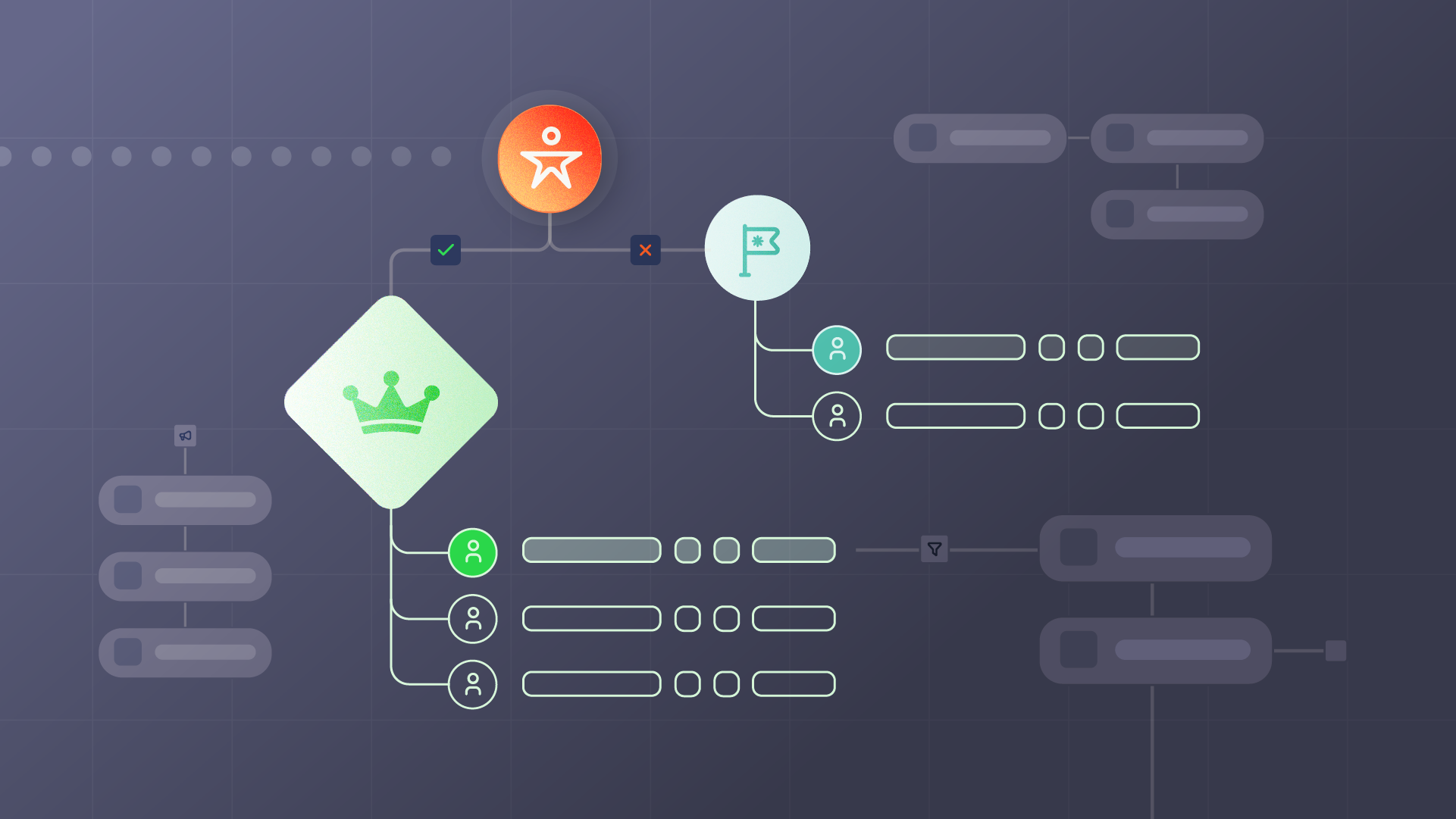AI adoption in business is skyrocketing – but the real impact has yet to be seen.
Enterprise businesses have invested an estimated $30 to $40 billion in generative AI tools over the past two years, yet 95% of organizations have seen little to no measurable ROI. The issue, according to MIT’s State of AI in Business 2025 Report, isn’t model quality, regulatory pressure, or a lack of enthusiasm – it’s execution.
The majority of enterprise AI systems fail not because they can’t generate value, but because they’re unable to learn, adapt, or integrate with the workflows they’re meant to improve.
Traction Complete’s most recent study, RevOps in the Age of AI: 2025 Leadership Guide, tells a similar story.
RevOps leaders and operators are eager to adopt AI, but pilots and progress are held back by a similar root cause: fragmented data and misaligned workflows. Additionally, the majority of RevOps leaders report mixed results or outright frustration when it comes to implementing AI.
Both reports underscore a similar realization – AI’s success relies on building the systems, data, and orchestration needed for AI models and implementation to scale.
That’s where these two worlds meet – and where RevOps can lead.
High-level findings between RevOps and Enterprise
| High-level findings between RevOps and enterprise | ||
|---|---|---|
| Enterprise (MIT) | RevOps (Traction Complete) | |
| AI adoption | 95% of organizations report no measurable ROI; only 5% of AI pilots have reached full production and delivered tangible business outcomes. | RevOps leaders and operators report strong interest and experimentation, but limited measurable impact. |
| Data | AI tools don’t adapt or improve over time because the data feeding them is fragmented, incomplete, or inconsistent across systems. | Incomplete or missing data enrichment is the #1 operational headache for both leaders and operators. Without clean, connected data, RevOps teams can’t fully leverage automation or AI-driven forecasting. |
| Build vs. buy | Internal builds fail roughly twice as often as vendor partnerships. Enterprises that succeed with AI co-develop with external partners who specialize in integration, contextual learning, and measurable business outcomes. | Not a single RevOps leader rated their in-house AI builds as “extremely successful.” Most found greater success with third-party solutions that could scale alongside GTM operations and data systems. |
| Fragmentation limits impact | Enterprise businesses often deploy dozens of isolated AI pilots across departments with little orchestration. The result? High activity, low ROI. | RevOps operators juggle disconnected platforms, while leaders spend time reconciling data across tools instead of acting on insights. |
| Experimentation vs. orchestration | Top-performing organizations are moving away from ad hoc pilots and towards integrated systems, where AI agents can coordinate workflows across functions. | RevOps leaders are embracing AI as a force multiplier for data hygiene, forecasting, and enrichment. The next step forward isn’t more tools, it’s cleaner data, connected systems, and orchestration across the revenue engine. |
Together, these reports build a consistent narrative. RevOps is battling the micro-level challenges of AI readiness and workflow integration, while enterprise businesses struggle with macro-level challenges that determine whether AI will actually transform the business.
3 Key Similarities Between RevOps and Enterprise AI
While the scale may differ, the challenges are nearly identical. Across industries and functions, teams are facing the same foundational hurdles – ones that need to be solved before AI can deliver tangible, long-term value.
1. Data quality is the foundation and the failure point
Both studies underscore one major truth: While AI promises to be the solution, poor data keeps even the best tools from delivering.
Our RevOps in the Age of AI: 2025 Leadership Guide finds that in RevOps, 59% of leaders and 73% of operators cite incomplete or missing enrichment as their biggest challenges. And while AI has the most potential to solve data challenges, its value is unlocked in stages.

You can’t use AI for effective enrichment or automation until you first use it to clean, standardize, and validate your data. The majority of RevOps leaders agree that until data is complete, automation risks amplifying chaos instead of creating clarity or solving problems.
“Incomplete or missing data enrichment undermines forecasting accuracy.”
Amulya, Senior Director of Revenue Operations – Traction Complete 2025 AI Leadership Survey Respondent
MIT’s State of AI in Business 2025 report backs this up on a wider scale, citing data fragmentation and poor contextual learning as the leading reasons why AI initiatives stall.
MIT calls this the learning gap – when AI tools can’t retain feedback or learn from historical outcomes because the data is inconsistent or siloed.
Both RevOps teams and enterprise businesses deal with the same struggle. The former, deals with CRM hygiene and enrichment; the latter, with fragmented data and siloes. Yet both sides show that data readiness is the foundation and starting block for AI maturity.
2. Build vs. buy: Partnerships outperform in-house AI pilots
In both studies, internal AI builds and pilots are producing disappointing results – often because they’re not treated like evolving, integrated systems.
Not a single RevOps leader rated their in-house AI tools as “extremely successful.” Many described them as promising in theory but too resource-heavy and difficult to maintain in practice. The most common success stories came from teams who chose vendor-supported tools that can integrate directly into their GTM stack.
Those teams found faster time-to-value and fewer roadblocks to adoption because vendor solutions provided data integration and workflow flexibility that their pilot systems lacked.
MIT’s findings echo that story – internal AI builds fail about twice as often as vendor partnerships.

The companies that do succeed approach AI through co-development, by working with specialized vendors who build contextual learning and feedback loops directly into existing workflows.
“Strategic partnerships achieved a significantly higher share of successful deployments than internal development efforts.”
The Gen AI Divide: State of AI in Business 2025, MIT
Overall, when it comes to building or buying, the fastest path to value isn’t through ownership – it’s through orchestration and integration.
Pro Tip: Build your AI pilots around RevOps processes
Sales, marketing, and customer success converge at RevOps, making it a natural starting point for AI automation. Also, unlike front-office experiments that often stall, RevOps processes are stable, repeatable, and deeply tied to revenue performance.
Leveraging AI here gives you reliable wins (that save hours of manual work), while also laying the groundwork or more advanced use cases tomorrow.
READ: Stop Chasing Flashy AI Projects: 5 AI RevOps Automations That Actually Work
3. Fragmented tools create fragmented value
Both RevOps and enterprise businesses share a universal pain around fragmentation – too many tools lead to too little alignment.
Both RevOps leaders and operators deal with fatigue from managing disconnected tech stacks. Operators spend hours switching between systems to validate or sync data, while leaders struggle to connect reporting across platforms.
As a result, the time spent doesn’t always equal the impact delivered. But this isn’t just a RevOps problem – it’s mirrored across enterprises.
MIT found that most organizations run dozens of isolated AI pilots, each confined to single teams or functions. Without integration, these tools generate localized wins but no organizational lift. This fragmentation traps companies in what MIT calls pilot purgatory: high experimentation, low transformation.
For both RevOps and enterprise AI leaders, the lesson is the same: value compounds when tools talk to each other. Whether you’re orchestrating your GTM systems or unifying enterprise data warehouses, the goal is the same – move from fragmented activity to connection.
Pro Tip: Less silos equals better data
Data silos are a massive hurdle in how businesses leverage AI, report, scale, and innovate.
RevOps data automation helps revenue teams work together on a shared data strategy, allowing users to see and action the data needed to operate more efficiently and effectively.
DOWNLOAD: 20+ Automation Flows for RevOps
Two Perspectives on AI Adoption: RevOps and Enterprise
Both the RevOps in the Age of AI and MIT State of AI in Business 2025 reports reveal a shared truth: AI adoption is less of a technology problem and more of an execution problem.
But that challenge shows up differently depending on where you sit.
At the RevOps level, the challenge is operational — balancing data quality, system alignment, and automation readiness.
At the enterprise level, it’s strategic — integrating AI at scale, across complex tech stacks and disconnected teams.
The RevOps lens: Data, alignment, and the road to AI readiness
While MIT’s report reveals the execution gap across enterprise businesses, Traction Complete’s findings show what that looks like inside RevOps.
Operators are deep in the data – cleaning, deduplicating, validating, and manually fixing CRM records. Leaders are focused on forecasting accuracy, pipeline visibility, and strategic predictability.
Both sides are essential to sustainable revenue growth. But at this point in time, they’re very much out of sync.
“Our team spends far too much time on CRM administration and territory management when the real driver of revenue is strategic forecasting and accurate data analysis.”
Nicholas, Senior Manager of Revenue Operations – Traction Complete 2025 AI Leadership Survey Respondent
AI has the potential to bridge that gap:
- Operators want to automate enrichment, reporting, and GTM insights
- Leaders want to enable forecasting, predict churn, and model data

The problem? These priorities depend on data that’s often unreliable or incomplete. That’s why data hygiene is both the biggest challenge and the biggest opportunity across every company size surveyed by Traction Complete.
The teams that clean, connect, and standardize their data now will be the ones ready to scale AI later.
The enterprise lens: MIT’s GenAI divide
MIT’s findings share another side of the story – what happens when organizations invest heavily in AI without solving their data or learning foundations first.
The GenAI Divide is where 5% of organizations extract massive value from Ai, while the other 95% remain stuck in that pilot purgatory.
“The hype on LinkedIn says everything has changed, but in our operations, nothing fundamental has shifted.”
COO, Mid-Market Manufacturing – MIT State of AI in Business 2025 Report
MIT’s report also suggests that the future lies in Agentic AI systems – tools that have memory, adaptability, and the ability to coordinate across multiple platforms. It’s described as the Agentic Web – a connected network of intelligent systems that can autonomously collaborate across different tools and vendors.
While that future is still far away, as a function that bridges marketing, sales, and customer success, RevOps can be the backbone that connects these adaptive systems when they arrive.
5 Steps for AI Readiness in RevOps
So what does this mean for RevOps leaders today? Based on the learnings from both Traction Complete and MIT’s reports, here are five steps you can take today for AI readiness.
1. Start by cleaning your data
Your CRM isn’t just a database. It’s the foundation every automation, forecast, and enrichment model stands on.
Before layering in new AI tools, start by strengthening what you already own:
- Audit your CRM: Identify duplicates, missing fields, and inconsistent data formats.
- Implement enrichment waterfalls: Blend multiple enrichment providers so if one source fails, another fills the gap.
- Validate and normalize data in real time: Standardize company names, industries, and hierarchies as they enter your system.
Clean data doesn’t just make your dashboards look better — it makes your AI systems smarter.
Pro Tip: The basics of clean Salesforce data and how to automate it
Clean data doesn’t just play a role in AI. It’s a critical step in protecting GTM data integrity, ensuring teams can trust their CRM, and supporting RevOps data management.
Learn about proactive and reactive data cleansing and get best practices for keeping your CRM clean.
READ: Salesforce Data Cleansing: Proactive and Reactive Strategies to Keep Your CRM Squeaky Clean
2. Focus on AI that lives in your workflows
Too many RevOps teams are chasing new tools to “solve” AI – but integration, not innovation, is where the value lies.
Instead of chasing new point solutions, focus on orchestration:
- Connect your CRM, marketing automation, and data enrichment systems.
- Ensure AI-driven workflows (like routing, scoring, or forecasting) draw from a single, verified data source.
- Align tools around the revenue process, not the department.
“If it doesn’t plug into Salesforce or our internal systems, no one’s going to use it.”
Respondent, MIT’s State of AI in Business 2025
When tools talk to each other, AI finally becomes useful — because it learns from the same story, not a dozen versions of it.
3. Use AI to create time, not just insights
Both reports point to a consistent pattern: AI is most valuable when it automates repetitive work so both RevOps leaders and Operators can focus on higher-value thinking.
In Traction Complete’s report, operators said they spend most of their time on CRM maintenance, manual reporting, and data hygiene — all necessary tasks, but none directly generate revenue.
AI can help reclaim that time. Start small by:
- Automating field updates and ownership assignments.
- Using AI-driven account enrichment to keep data up-to-date.
- Automating report creation and anomaly detection to highlight pipeline risk faster.
The more time saved on manual hygiene tasks means more time for strategic enablement – think forecasting, pipeline planning, and other activities that have a direct impact on your bottom line.
4. Empower operators, guide with strategy
MIT’s research shows that in many enterprises, AI innovation is happening “in the shadows” — with employees experimenting independently. That same trend is likely already happening within RevOps.
RevOps operators are already adopting AI tools on their own to speed up daily work. The opportunity for leaders is to channel that curiosity into alignment.
Give your operators a sandbox to experiment — and connect those experiments to organizational goals. Encourage small wins that scale:
- Pilot AI in one workflow, like account scoring or territory assignment.
- Track results in business metrics, not tool metrics.
- Share learnings cross-functionally so adoption compounds
5. Understand AI impact by measuring the right ROI metrics
MIT’s data shows that the organizations crossing the GenAI Divide are those measuring ROI, not activity.
Instead of tracking adoption metrics, such as number of AI tools in use, measure operational impact:
- How much manual work has been automated?
- How accurate are your forecasts compared to last quarter?
- How fast can insights travel between systems?
For RevOps, success isn’t about AI usage — it’s about AI leverage and saving time on manual tasks.
AI stops being a pilot and starts being an advantage when:
- Automation improves efficiency
- Data enrichment drives accuracy
- Orchestration drives alignment

Build the foundation you need to unlock AI’s full potential in RevOps
We surveyed RevOps leaders and operators to understand how they’re navigating the age of AI.
Get an inside look into where businsesses are spending their time, where priorities align and diverge, and the biggest opportunities for AI in RevOps.
Bringing RevOps AI Back to What Works with Traction Complete
AI may be driving the headlines, but data is what drives results.
As both the MIT and Traction Complete reports show, no model, platform, or algorithm can outperform the quality of the data behind it.
For RevOps, this means the real opportunity isn’t to chase the next wave of AI hype — it’s to master the foundation that makes AI work. When your data is clean, structured, and connected across systems, every insight becomes sharper, every forecast becomes more accurate, and every workflow becomes more intelligent.
Ready to start leveraging AI realistically? Book a demo today.




